2016 Hyundai Santa Fe display
[x] Cancel search: displayPage 563 of 759
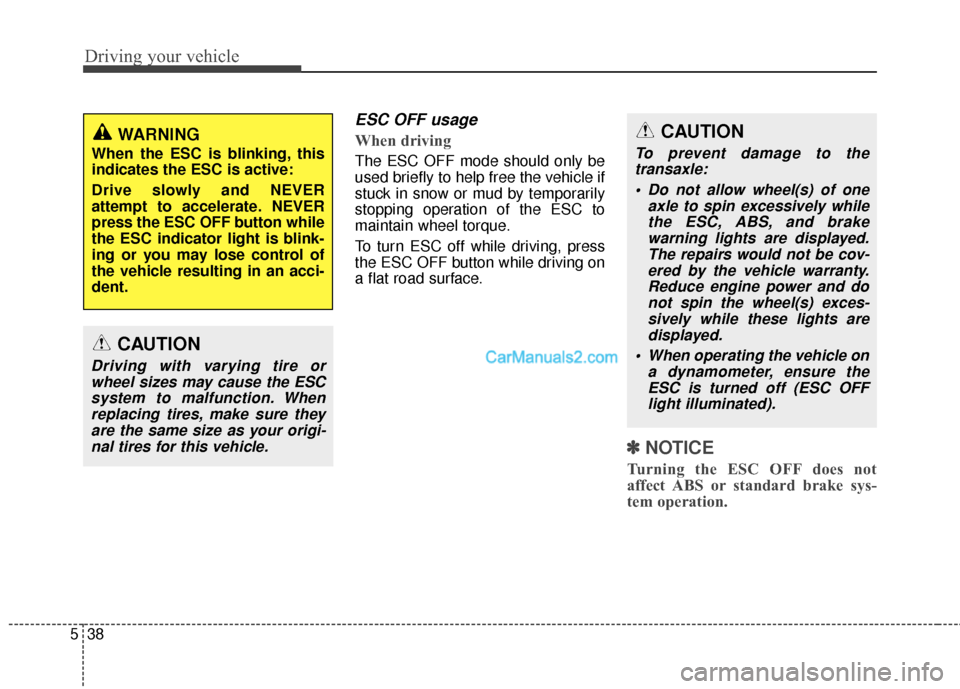
Driving your vehicle
38
5
ESC OFF usage
When driving
The ESC OFF mode should only be
used briefly to help free the vehicle if
stuck in snow or mud by temporarily
stopping operation of the ESC to
maintain wheel torque.
To turn ESC off while driving, press
the ESC OFF button while driving on
a flat road surface.
✽ ✽
NOTICE
Turning the ESC OFF does not
affect ABS or standard brake sys-
tem operation.
CAUTION
To prevent damage to the
transaxle:
Do not allow wheel(s) of one axle to spin excessively whilethe ESC, ABS, and brakewarning lights are displayed.The repairs would not be cov-ered by the vehicle warranty.Reduce engine power and donot spin the wheel(s) exces-sively while these lights aredisplayed.
When operating the vehicle on a dynamometer, ensure theESC is turned off (ESC OFFlight illuminated).
WARNING
When the ESC is blinking, this
indicates the ESC is active:
Drive slowly and NEVER
attempt to accelerate. NEVER
press the ESC OFF button while
the ESC indicator light is blink-
ing or you may lose control of
the vehicle resulting in an acci-
dent.
CAUTION
Driving with varying tire orwheel sizes may cause the ESCsystem to malfunction. Whenreplacing tires, make sure theyare the same size as your origi-nal tires for this vehicle.
Page 618 of 759
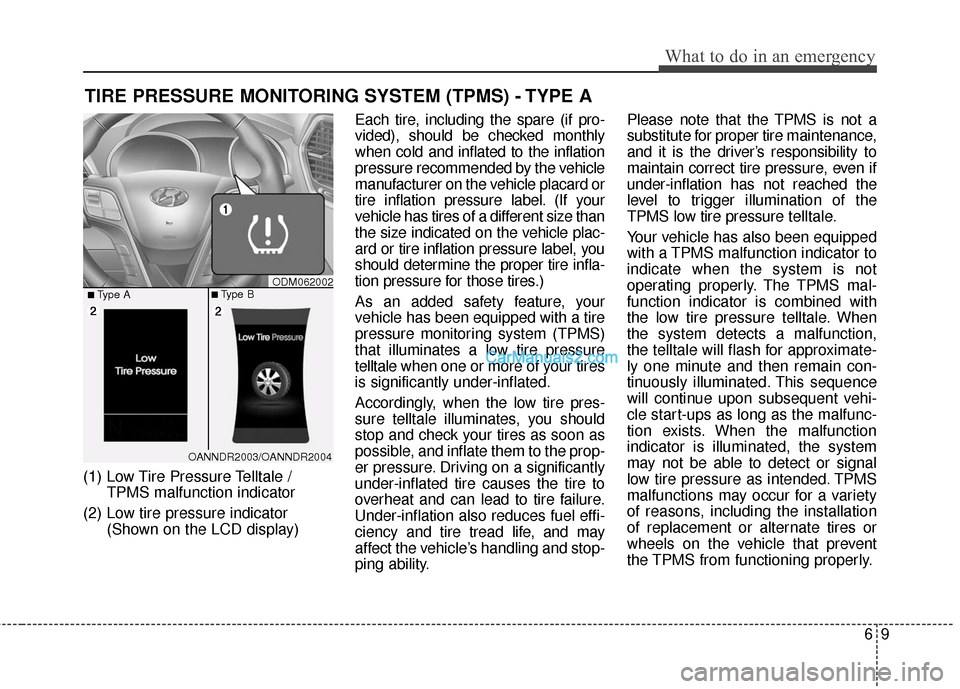
69
What to do in an emergency
TIRE PRESSURE MONITORING SYSTEM (TPMS) - TYPE A
(1) Low Tire Pressure Telltale / TPMS malfunction indicator
(2) Low tire pressure indicator (Shown on the LCD display) Each tire, including the spare (if pro-
vided), should be checked monthly
when cold and inflated to the inflation
pressure recommended by the vehicle
manufacturer on the vehicle placard or
tire inflation pressure label. (If your
vehicle has tires of a different size than
the size indicated on the vehicle plac-
ard or tire inflation pressure label, you
should determine the proper tire infla-
tion pressure for those tires.)
As an added safety feature, your
vehicle has been equipped with a tire
pressure monitoring system (TPMS)
that illuminates a low tire pressure
telltale
when one or more of your tires
is significantly under-inflated.
Accordingly, when the low tire pres-
sure telltale illuminates, you should
stop and check your tires as soon as
possible, and inflate them to the prop-
er pressure. Driving on a significantly
under-inflated tire causes the tire to
overheat and can lead to tire failure.
Under-inflation also reduces fuel effi-
ciency and tire tread life, and may
affect the vehicle’s handling and stop-
ping ability. Please note that the TPMS is not a
substitute for proper tire maintenance,
and it is the driver’s responsibility to
maintain correct tire pressure, even if
under-inflation has not reached the
level to trigger illumination of the
TPMS low tire pressure telltale.
Your vehicle has also been equipped
with a TPMS malfunction indicator to
indicate when the system is not
operating properly. The TPMS mal-
function indicator is combined with
the low tire pressure telltale. When
the system detects a malfunction,
the telltale will flash for approximate-
ly one minute and then remain con-
tinuously illuminated. This sequence
will continue upon subsequent vehi-
cle start-ups as long as the malfunc-
tion exists. When the malfunction
indicator is illuminated, the system
may not be able to detect or signal
low tire pressure as intended. TPMS
malfunctions may occur for a variety
of reasons, including the installation
of replacement or alternate tires or
wheels on the vehicle that prevent
the TPMS from functioning properly.
ODM062002■Type A■Type B
OANNDR2003/OANNDR2004
Page 623 of 759
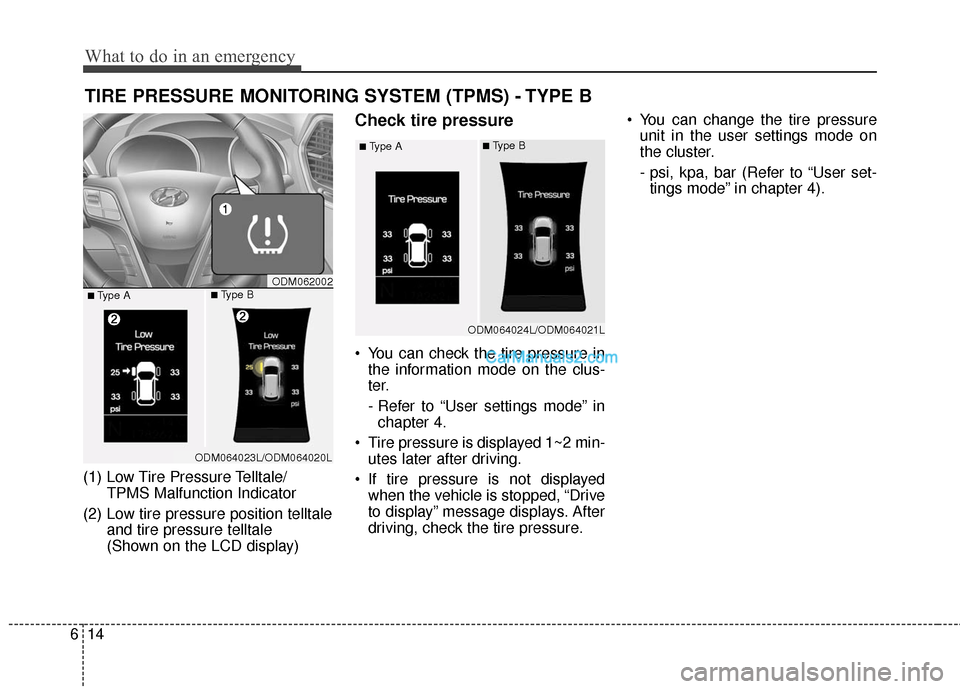
What to do in an emergency
14
6
TIRE PRESSURE MONITORING SYSTEM (TPMS) - TYPE B
(1) Low Tire Pressure Telltale/
TPMS Malfunction Indicator
(2) Low tire pressure position telltale and tire pressure telltale
(Shown on the LCD display)
Check tire pressure
You can check the tire pressure inthe information mode on the clus-
ter.
- Refer to “User settings mode” inchapter 4.
Tire pressure is displayed 1~2 min- utes later after driving.
If tire pressure is not displayed when the vehicle is stopped, “Drive
to display” message displays. After
driving, check the tire pressure. You can change the tire pressure
unit in the user settings mode on
the cluster.
- psi, kpa, bar (Refer to “User set-tings mode” in chapter 4).
ODM062002
ODM064023L/ODM064020L
■Type A■Type B
ODM064024L/ODM064021L
■Type A■Type B
Page 625 of 759

What to do in an emergency
16
6
✽
✽
NOTICE
If any of the below happens, we rec-
ommend that the system be checked
by an authorized HYUNDAI dealer.
1.The low tire pressure telltale/
TPMS malfunction indicator does
not illuminate for 3 seconds when
Engine Start/Stop button is turned
to the ON or engine is running.
2. The TPMS malfunction indicator remains illuminated after blinking
for approximately 1 minute.
3. The Low tire pressure position telltale remains illuminated.
Low tire pressure
telltale
Low tire pressure position tell-
tale and tire pressure telltale
When the tire pressure monitoring
system warning indicators are illumi-
nated and warning massage dis-
played on the cluster LCD display,
one or more of your tires is signifi-
cantly under-inflated. The low tire
pressure position telltale light will
indicate which tire is significantly
under-inflated by illuminating the cor-
responding position light. If either telltale illuminates, immedi-
ately reduce your speed, avoid hard
cornering and anticipate increased
stopping distances. You should stop
and check your tires as soon as pos-
sible. Inflate the tires to the proper
pressure as indicated on the vehi-
cle’s placard or tire inflation pressure
label located on the driver’s side cen-
ter pillar outer panel. If you cannot
reach a service station or if the tire
cannot hold the newly added air,
replace the low pressure tire with a
spare tire.
If you drive the vehicle for about 10
minutes at speeds above 15.5 mph
(25 km/h) after replacing the low
pressure tire with the spare tire, the
below will happen:
The TPMS malfunction indicator
may blink for approximately 1
minute and then remain continu-
ously illuminated because the
TPMS sensor is not mounted on
the spare wheel.
ODM064023L/ODM064020L
■Type A■Type B
Page 626 of 759

617
What to do in an emergency
✽
✽NOTICE
The spare tire is not equipped with a
tire pressure sensor.
TPMS (Tire Pressure
Monitoring System)
malfunction indicator
The TPMS malfunction indicator will
illuminate after it blinks for approxi-
mately one minute when there is a
problem with the Tire Pressure
Monitoring System.
We recommend that the system be
checked by an authorized HYUNDAI
dealer.
✽ ✽NOTICE
If there is a malfunction with the
TPMS, the low tire pressure position
telltale will not be displayed even
though the vehicle has an under-
inflated tire.
CAUTION
In winter or cold weather, the
low tire pressure telltale mayilluminate if the tire pressurewas adjusted to the recom-mended tire inflation pressurein warm weather. It does notmean your TPMS is malfunction-ing because the decreased tem-perature leads to a lowering oftire pressure.
When you drive your vehiclefrom a warm area to a cold areaor from a cold area to a warmarea, or the outside temperatureis higher or lower, you shouldcheck the tire inflation pressureand adjust the tires to the rec-ommended tire inflation pres-sure.
WARNING- Low pressure
damage
Significantly low tire pressure
makes the vehicle unstable and
can contribute to loss of vehicle
control and increased braking
distances.
Continued driving on low pres-
sure tires can cause the tires to
overheat and fail.
Page 697 of 759
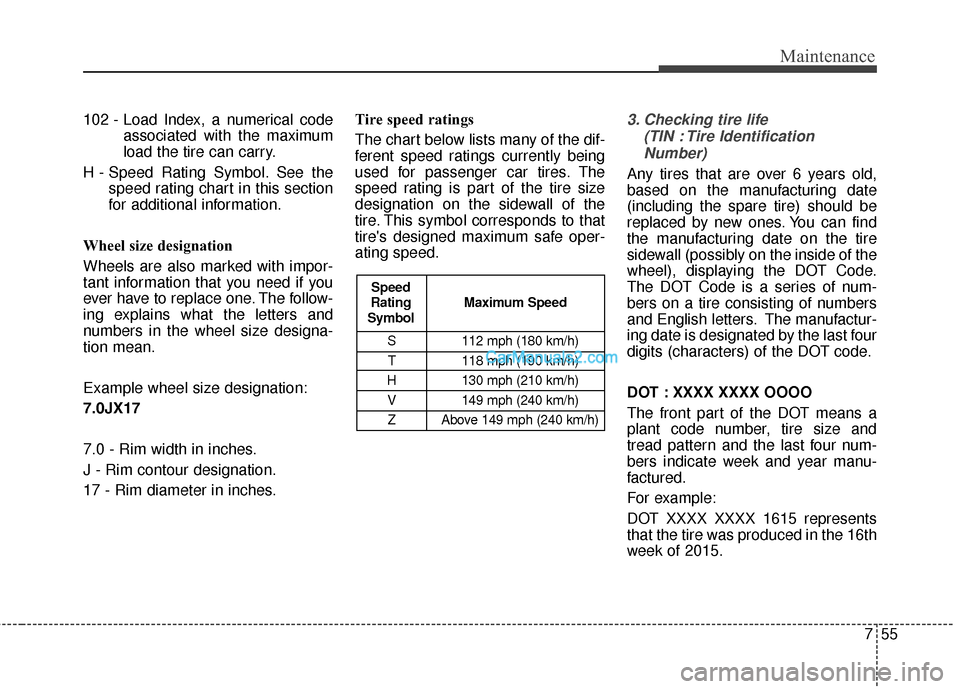
755
Maintenance
102 - Load Index, a numerical codeassociated with the maximum
load the tire can carry.
H - Speed Rating Symbol. See the speed rating chart in this section
for additional information.
Wheel size designation
Wheels are also marked with impor-
tant information that you need if you
ever have to replace one. The follow-
ing explains what the letters and
numbers in the wheel size designa-
tion mean.
Example wheel size designation:
7.0JX17
7.0 - Rim width in inches.
J - Rim contour designation.
17 - Rim diameter in inches. Tire speed ratings
The chart below lists many of the dif-
ferent speed ratings currently being
used for passenger car tires. The
speed rating is part of the tire size
designation on the sidewall of the
tire. This symbol corresponds to that
tire's designed maximum safe oper-
ating speed.3. Checking tire life
(TIN : Tire IdentificationNumber)
Any tires that are over 6 years old,
based on the manufacturing date
(including the spare tire) should be
replaced by new ones. You can find
the manufacturing date on the tire
sidewall (possibly on the inside of the
wheel), displaying the DOT Code.
The DOT Code is a series of num-
bers on a tire consisting of numbers
and English letters. The manufactur-
ing date is designated by the last four
digits (characters) of the DOT code.
DOT : XXXX XXXX OOOO
The front part of the DOT means a
plant code number, tire size and
tread pattern and the last four num-
bers indicate week and year manu-
factured.
For example:
DOT XXXX XXXX 1615 represents
that the tire was produced in the 16th
week of 2015.
S 112 mph (180 km/h)
T 118 mph (190 km/h)
H 130 mph (210 km/h) V 149 mph (240 km/h)Z Above 149 mph (240 km/h)
Maximum Speed
Speed
Rating
Symbol
Page 752 of 759
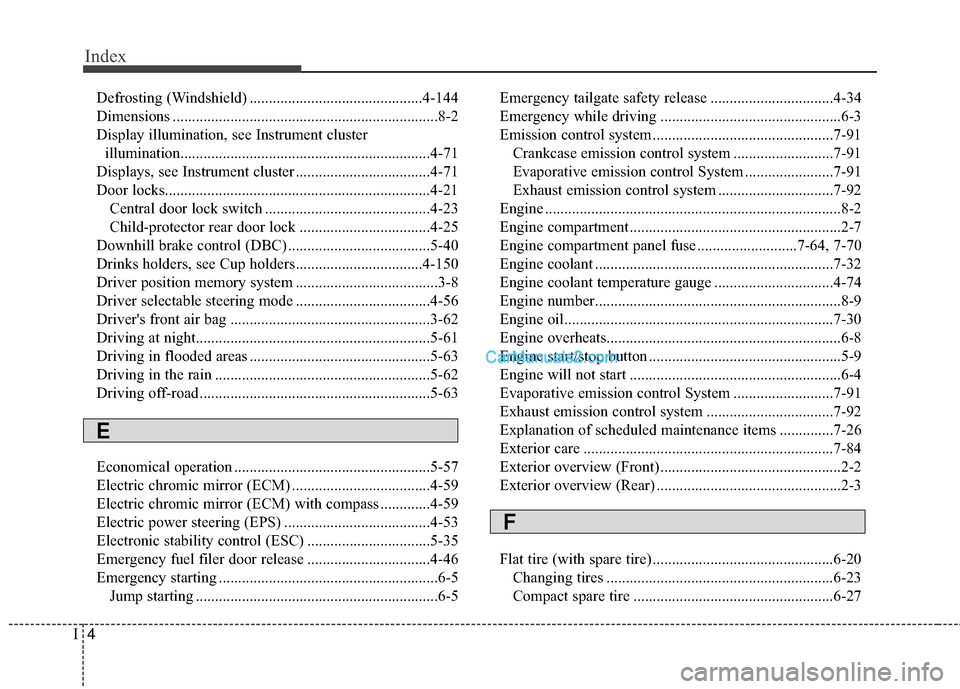
Index
4I
Defrosting (Windshield) .............................................4-144
Dimensions .....................................................................8-2\
Display illumination, see Instrument cluster illumination.................................................................4-71
Displays, see Instrument cluster ...................................4-71
Door locks..............................................................\
.......4-21 Central door lock switch ...........................................4-23
Child-protector rear door lock ..................................4-25
Downhill brake control (DBC) .....................................5-40
Drinks holders, see Cup holders.................................4-150
Driver position memory system .....................................3-8
Driver selectable steering mode ...................................4-56
Driver's front air bag ....................................................3-62
Driving at night.............................................................5-61
Driving in flooded areas ...............................................5-63
Driving in the rain ........................................................5-62
Driving off-road ............................................................5-63
Economical operation ...................................................5-57
Electric chromic mirror (ECM) ....................................4-59
Electric chromic mirror (ECM) with compass .............4-59
Electric power steering (EPS) ......................................4-53
Electronic stability control (ESC) ................................5-35
Emergency fuel filer door release ................................4-46
Emergency starting .........................................................6-5 Jump starting ...............................................................6-5 Emergency tailgate safety release ................................4-34
Emergency while driving ...............................................6-3
Emission control system ...............................................7-91
Crankcase emission control system ..........................7-91
Evaporative emission control System .......................7-91
Exhaust emission control system ..............................7-92
Engine ........................................................................\
.....8-2
Engine compartment .......................................................2-7
Engine compartment panel fuse ..........................7-64, 7-70
Engine coolant ..............................................................7-32
Engine coolant temperature gauge ...............................4-74
Engine number................................................................8-9
Engine oil......................................................................7-\
30
Engine overheats.............................................................6-8
Engine start/stop button ..................................................5-9
Engine will not start .......................................................6-4
Evaporative emission control System ..........................7-91
Exhaust emission control system .................................7-92
Explanation of scheduled maintenance items ..............7-26
Exterior care .................................................................7-84
Exterior overview (Front) ...............................................2-2
Exterior overview (Rear) ................................................2-3
Flat tire (with spare tire) ...............................................6-20 Changing tires ...........................................................6-23
Compact spare tire ....................................................6-27
E
F
Page 754 of 759
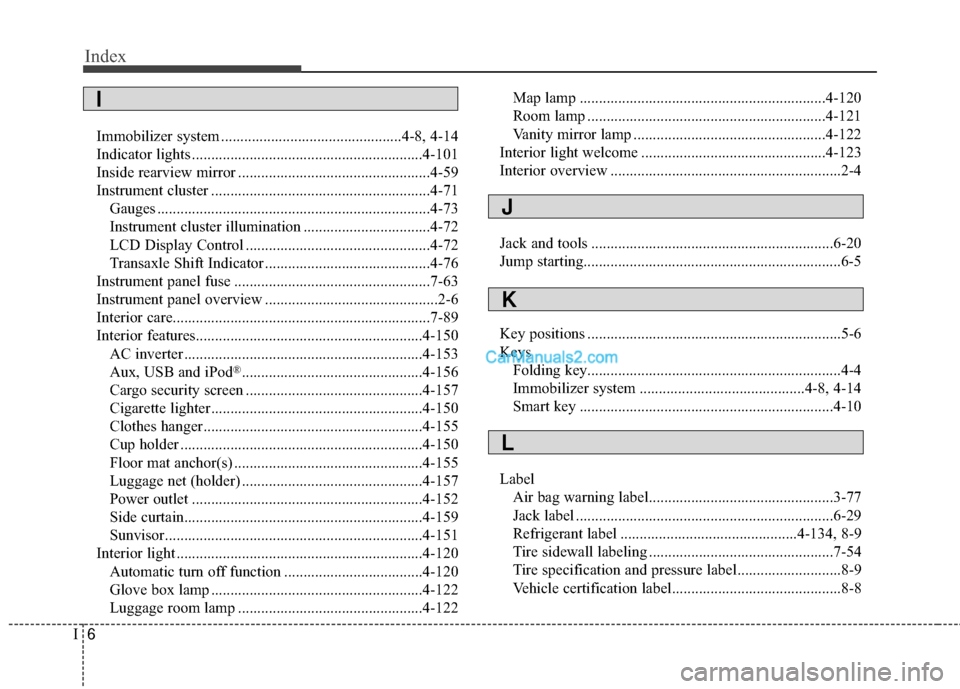
Index
6I
Immobilizer system ...............................................4-8, 4-14
Indicator lights ............................................................4-101
Inside rearview mirror ..................................................4-59
Instrument cluster .........................................................4-71Gauges .......................................................................4\
-73
Instrument cluster illumination .................................4-72
LCD Display Control ................................................4-72
Transaxle Shift Indicator ...........................................4-76
Instrument panel fuse ...................................................7-63
Instrument panel overview .............................................2-6
Interior care...................................................................7-89
Interior features...........................................................4-150 AC inverter ..............................................................4-153
Aux, USB and iPod
®...............................................4-156
Cargo security screen ..............................................4-157
Cigarette lighter.......................................................4-150
Clothes hanger.........................................................4-155
Cup holder ...............................................................4-150
Floor mat anchor(s) .................................................4-155
Luggage net (holder) ...............................................4-157
Power outlet ............................................................4-152
Side curtain..............................................................4-159
Sunvisor...................................................................4-151\
Interior light ................................................................4-120 Automatic turn off function ....................................4-120
Glove box lamp .......................................................4-122
Luggage room lamp ................................................4-122 Map lamp ................................................................4-120
Room lamp ..............................................................4-121
Vanity mirror lamp ..................................................4-122
Interior light welcome ................................................4-123
Interior overview ............................................................2-4
Jack and tools ...............................................................6-20
Jump starting...........................................................\
........6-5
Key positions ..................................................................5-6
Keys Folding key..................................................................4-4
Immobilizer system ...........................................4-8, 4-14
Smart key ..................................................................4-10
Label Air bag warning label................................................3-77
Jack label ...................................................................6-29
Refrigerant label ..............................................4-134, 8-9
Tire sidewall labeling ................................................7-54
Tire specification and pressure label...........................8-9
Vehicle certification label............................................8-8
I
K
J
L